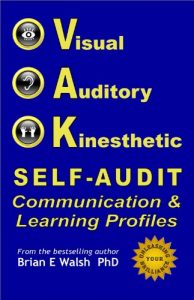Want to be a more effective at work and at home?
This subjective assessment is designed to help you discover your primary communication and learning style. It will shed light on how you relate to others and reveals how you run your relationships, both personal and professional. Better communicators achieve more success in all aspects of life.
Confusion and misunderstandings happen for many reasons.
People communicate, both verbally and non-verbally, in a diversity of styles. It’s almost as if they are speaking different languages. Knowing how these different styles clash, can help you put your ideas across more clearly and give your point of view greater acceptance. It just makes sense to learn and use these skills.
There are many communication models. This particular one, from the field of Neurolinguistic Programming (NLP), is commonly known as VAK (Visual, Auditory, and Kinesthetic). Science Digest stated: “NLP could be the most important synthesis of knowledge about human communication to emerge since the explosion of humanistic psychology in the sixties.”
The full VAK model is quite detailed, so this book just provides a brief overview to set the stage for the self-audit. As you begin to explore VAK, remember that, as with other models, all of us possess varying mixtures of all styles.
As with most abilities, these communication skills will quickly improve with practice. To begin, apply these concepts in your everyday communication at work and at home. In time, your improved capabilities and skills will become second nature.
To better understand this communications model, study the characteristics of the three styles shown in the first few pages. Do the short review exercise, and then take the self-audit. In the following days, observe your family, friends, and colleagues. Soon you will notice the patterns in their communication styles.
This subjective assessment is designed to help you discover your primary communication and learning style. It will shed light on how you relate to others and reveals how you run your relationships, both personal and professional. Better communicators achieve more success in all aspects of life.
Confusion and misunderstandings happen for many reasons.
People communicate, both verbally and non-verbally, in a diversity of styles. It’s almost as if they are speaking different languages. Knowing how these different styles clash, can help you put your ideas across more clearly and give your point of view greater acceptance. It just makes sense to learn and use these skills.
There are many communication models. This particular one, from the field of Neurolinguistic Programming (NLP), is commonly known as VAK (Visual, Auditory, and Kinesthetic). Science Digest stated: “NLP could be the most important synthesis of knowledge about human communication to emerge since the explosion of humanistic psychology in the sixties.”
The full VAK model is quite detailed, so this book just provides a brief overview to set the stage for the self-audit. As you begin to explore VAK, remember that, as with other models, all of us possess varying mixtures of all styles.
As with most abilities, these communication skills will quickly improve with practice. To begin, apply these concepts in your everyday communication at work and at home. In time, your improved capabilities and skills will become second nature.
To better understand this communications model, study the characteristics of the three styles shown in the first few pages. Do the short review exercise, and then take the self-audit. In the following days, observe your family, friends, and colleagues. Soon you will notice the patterns in their communication styles.






